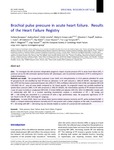Brachial pulse pressure in acute heart failure. Results of the Heart Failure Registry

View/
Use this link to cite
http://hdl.handle.net/2183/24569Collections
- Investigación (FEP) [507]
Metadata
Show full item recordTitle
Brachial pulse pressure in acute heart failure. Results of the Heart Failure RegistryAuthor(s)
Date
2019-12-09Citation
Bonapace S, Rossi A, Laroche C, Crespo-Leiro M, Piepoli MF, Coats AJS, et al. Brachial pulse pressure in acute heart failure. Results of the Heart Failure Registry. ESC Heart Fail. 2019
Abstract
[Abstract]
Aims To investigate the still uncertain independent prognostic impact of pulse pressure (PP) in acute heart failure (HF), in particular across the left ventricular ejection fraction (EF) phenotypes, and the potential contribution of PP in outlining the individual phenotypes. Methods and results We prospectively evaluated 1-year death and rehospitalization in 4314 patients admitted for acute HF grouped by EF and stratified by their PP level on admission. In HF with reduced (< 40%) EF (HFrEF), the highest quartiles of PP had the lowest unadjusted [hazard ratio (HR) 0.77, 95% confidence interval (CI) 0.61–0.98] and adjusted (HR 0.64 0.50–0.82) risk of 1 year all cause death compared to the lowest quartile. Its prognostic impact was partially mediated by systolic blood pressure (SBP). In HF with preserved (≥ 50%) EF (HFpEF), the intermediate quartile of PP showed the lowest 1 year all cause mortality in unadjusted (HR 0.598, CI 0.416–0.858) and adjusted (HR 0.55, 95% CI 0.388-0.801) models with no relationship with SBP. In a receiver operating characteristic analysis, a combination of PP > 60 mmHg and SBP > 140 mmHg was associated to a preserved EF with a high performance value. No prognostic significance of PP was found in the HF with mid-range EF subgroup. Conclusions In acute HFrEF, there is an almost linear inverse relation between mortality and PP, partly mediated by SBP. In HFpEF, a J-shaped relationship between mortality and PP was present with a better prognosis at the nadir. A combination of PP > 60 mmHg with SBP > 140 mmHg may be clinically helpful as marker of a preserved left ventricular EF.
Keywords
Pulse pressure
Heart failure
Acute heart failure
Prognosis
Heart failure
Acute heart failure
Prognosis
Editor version
Rights
Atribución-NoComercial 3.0 España
ISSN
2055-5822





